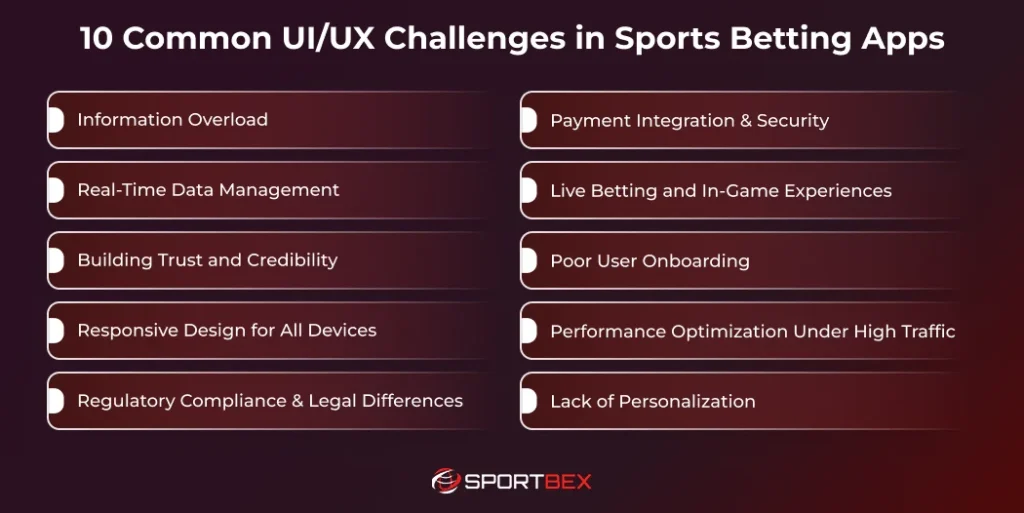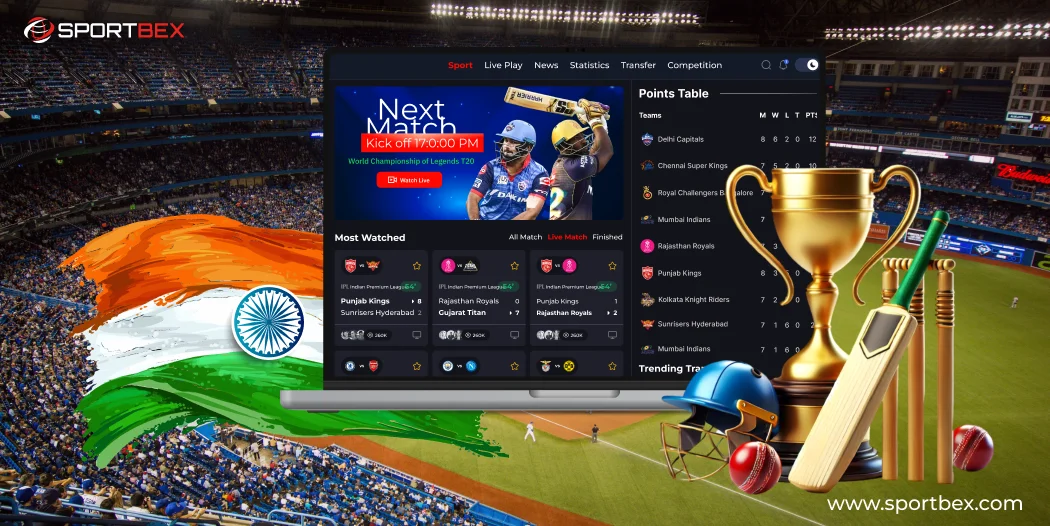Sports betting apps have become incredibly popular, changing how millions of people enjoy their favorite sports. Whether it’s placing a quick bet during halftime or following live odds, these apps have made the betting experience easier and more exciting. But creating a successful sports betting app isn’t just about offering good odds or lots of options – it’s all about the user experience.
If you’re rushing to place a bet right before kickoff or managing multiple live bets at once, every second matters. A confusing layout, slow loading times, or hard-to-use navigation can frustrate users and send them to a competitor’s app. That’s why great UI/UX design is the key to building sports betting apps that users love.
Designing these apps is much harder than other types of apps. Instead of browsing casually like on a shopping app, users need to make quick decisions with lots of real-time data like odds, stats, and betting options. On top of that, users need to feel that the app is secure and reliable.
What makes this even more interesting is how fast the sports betting industry is changing. New rules, technologies, and user expectations mean betting apps must constantly improve their design to keep users happy. Whether you’re a designer looking to avoid common mistakes or a business owner wanting to build a better app, understanding these challenges is essential.
In this guide, we’ll look at the 10 UI/UX Design Challenges in Sports Betting Apps and share practical solutions. From simplifying complicated information to making onboarding easy, these tips will help you create a betting app that users love to use!
Why UI/UX Design is Important in Sports Betting Apps
UI/UX design is crucial for sports betting apps, especially in a highly competitive market where user loyalty depends on a smooth digital experience. Bettors don’t just compare odds—they want an app that is easy, enjoyable, and trustworthy.
A bettor opens the app minutes before a game, needs to quickly find their market, place a bet, and confirm the transaction. If the app has slow loading times, confusing navigation, or unclear betting slips, users will switch to a competitor with a better experience.
Sports betting apps also handle sensitive information like personal and financial data. Users need to feel secure, and the design must reflect trustworthiness. Cluttered layouts, poor visuals, or confusing payment steps can make users worry about safety, even if the backend is secure.
When real money is involved, the stakes are even higher. Every button, odds display, and confirmation needs to be clear to avoid mistakes. A confusing design—especially when integrated with a Sports Odds API—can lead to user errors, lost trust, and even legal issues for the app. That’s why great UX design isn’t just nice to have—it’s a must.
10 Common UI/UX Challenges in Sports Betting Apps

1. Information Overload
Sports betting apps face a big challenge: showing lots of information without confusing users. Every sport produces tons of data—team stats, player performance, live scores, betting odds, and more. It’s tempting to show everything at once, but that often overwhelms users.
When people open a sports betting app, they usually want specific information fast, like the latest odds for a game or a certain betting market. A well-designed sports betting UI ensures that users can access this information quickly and easily. If the screen is crammed with stats, odds formats, and too many betting options, users can feel frustrated instead of confident. Simple and clear design is key.
Sports betting apps simplify the user experience by organizing information effectively. Key details, like popular betting options, are shown upfront, while additional info is neatly stored in labeled sections. Smart filters and personalization learn user preferences, highlighting relevant options. This creates a smoother and more tailored experience for every user.
2. Real-Time Data Management
Managing live data is one of the toughest parts of designing a sports betting app. Sports events produce constant updates—scores change, odds shift, player stats update, and new bets pop up every few seconds. The challenge is to show this fast-changing information clearly while keeping the app running smoothly.
It’s not just about showing updates; users need to quickly understand what’s changing and why it matters. For example, if odds change during a live game, users should be able to tell if it’s a good opportunity or if it affects their current bets. This means using clear visuals, animations, and notifications that highlight important changes without overwhelming users.
Sports Data Feeds provide the numbers, but great UX turns them into actionable insights. Clear layouts, color coding, and subtle animations help users focus on what matters without being data experts. Real-time updates demand speed, so designers and developers must collaborate on techniques like smart caching and efficient rendering for smooth, instant responses.
3. Building Trust and Credibility
Trust is the foundation of successful sports betting apps. Users are putting their money on the line, so they need to feel confident that the platform is reliable, secure, and fair. This trust should come through in every part of the app’s design.
A clean, professional look helps build credibility. Polished visuals show that the platform is high-quality and trustworthy. On the other hand, outdated or messy designs can make users question whether the app is legitimate, even if it’s secure and reliable.
Building trust starts with transparency—clearly display licensing, odds, and simple terms while ensuring customer support is easily accessible. Highlight security with encryption symbols, badges, and clear payment details to reassure users their data is safe. Boost credibility with genuine reviews, regulatory approvals, and industry awards, keeping everything authentic and approachable.
4. Responsive Design for All Devices
Designing a responsive sports betting app isn’t just about resizing interfaces for different screens. Sports bettors often switch between devices—checking odds on their phone during lunch, placing bets on a tablet at home, or following live games on their computer. Each device has its own strengths and limitations that need to be addressed.
While most users rely on their phones for sports betting, small screens can make design tricky. Mobile apps need to include all the important features without feeling cluttered or hard to use. A good design focuses on the key features and ensures other functions are easy to find with simple, user-friendly navigation.
Tablet interfaces combine mobile convenience with desktop functionality, making multitasking easier for users, like live streaming while placing bets. Betting apps need clear layouts, large buttons, and confirmations to prevent errors. Seamless syncing across devices ensures users can access preferences, bet slips, and account info anytime.
5. Regulatory Compliance & Legal Differences
Sports betting platforms face a big challenge: following strict rules while keeping the user experience smooth. Different areas have different rules, like checking a user’s age, promoting responsible gambling, handling data, and limiting ads. These rules can impact how the platform looks and works, making it harder for users to enjoy.
For example, age and identity checks are required in most regulated markets, but they can slow down the sign-up process. The key is to make these steps as simple and clear as possible while still following the rules. Good design helps guide users through the process, explaining what they need to do and why it’s important.
Responsible gambling tools like deposit limits and reminders should be easy to find and use without disrupting the experience. For mobile users, apps need smooth geolocation checks and clear guidance when betting is restricted. Privacy rules like GDPR require apps to be transparent about data use, offering simple, user-friendly privacy settings.
6. Payment Integration & Security
Processing payments in sports betting apps needs to be secure and easy to use. Users want to quickly deposit money for bets and get their winnings fast. If the payment process is slow or difficult, they might switch to a competitor with a better system.
Today’s users expect a wide range of payment options in sports betting apps, including credit cards, bank transfers, digital wallets, cryptocurrency, prepaid cards, and local methods. Each option requires thoughtful UX planning for design, security, and verification. The challenge is to manage this complexity while ensuring a seamless user experience (UX) in sports betting software.
Financial transactions must balance security and simplicity. Features like multi-factor authentication and fraud detection improve safety but can frustrate users. The best systems adapt security based on transaction size, keeping small transactions easy and larger ones secure. Clear, real-time tracking of deposits, withdrawals, and bonuses is essential, along with immediate, simple confirmations to reduce confusion and stress.
7. Live Betting and In-Game Experiences
Live betting is one of the most exciting parts of sports betting apps, but it’s also the most challenging to design. When users bet on games as they happen, every second counts. Odds change quickly, new betting options come and go, and users need to act fast.
This means the app needs to be super responsive. If there’s any delay, slow loading, or confusion in the process, users can miss their chance to place a bet or get frustrated. A smooth, fast experience is key during live betting.
Live events require clear, accessible information like scores, time left, and betting options, with detailed stats available for deeper insights. Sports Betting APIs enhance these experiences by delivering real-time data, but it must be presented clearly. Live betting adds challenges, so interfaces should simplify placing and adjusting bets while preventing errors during fast-paced moments.
8. Poor User Onboarding
First impressions are everything in sports betting! New users have plenty of platforms to choose from, so their first experience often decides if they stay or switch to another option. A bad onboarding process can waste money spent on getting new customers and leave a bad impression that’s hard to fix.
The registration process needs to follow rules, like verifying identity and collecting documents, while still being easy for users. Good onboarding breaks these steps into simple, clear tasks and explains why they’re needed and how long they’ll take.
Content for beginners in sports betting is essential, but experienced users should be able to skip it and start betting quickly. Personalized onboarding, like asking about favorite sports or betting habits, helps tailor the experience and boost engagement. Gradually introducing features—starting with basics and adding advanced options like live betting—ensures users feel confident as they navigate the platform.
9. Performance Optimization Under High Traffic
Sports betting apps see massive traffic spikes during big events like the Super Bowl or World Cup finals—up to 10-20 times more than usual. During these times, it’s crucial for apps to stay fast and responsive, as users won’t wait around when placing bets.
To handle this, apps need strong back-end systems, including enough server power, optimized databases, and tools like load balancing and content delivery networks. But it’s not just the tech—good UX design also helps ensure the app works smoothly under pressure.
During high-traffic times, apps can simplify features to ensure fast performance, focusing on essentials like placing bets. This might mean updating live odds less frequently or reducing access to detailed stats. Clear communication and “graceful degradation” ensure key functions like betting and support remain available.
10. Lack of Personalization
One-size-fits-all sports betting apps just don’t work. Every bettor is different, with unique interests, experience levels, favorite sports, and betting habits. Apps that treat everyone the same miss the chance to keep users engaged.
For example, someone who only bets on basketball shouldn’t have to scroll through soccer or tennis options to find what they want. Smart personalization solves this by showing users the sports, leagues, and bets that match their preferences and past activity. It’s all about making the experience relevant and easy to use.
Betting apps can improve experiences by understanding user habits, from simple bets to live betting excitement. New users need guides and simplicity, while experienced bettors prefer advanced tools and quick workflows. Personalization ensures apps highlight the right features for each user. Partnering with a betting website UIUX agency helps create smart, user-friendly designs.
How Can Sportbex Theme Solve These UX Challenges?
The Sportbex theme is designed to tackle common challenges in sports betting app design. It includes high-performance sports data feeds and user-friendly layouts, making it easy to meet both user and business needs.
Key Strengths of the Sportbex Theme:
- Live Data Updates: Uses fast APIs for smooth live betting.
- Customizable Designs: Ready-made templates that are clear and user-friendly.
- Fast and Reliable: Designed to handle high traffic without slowing down.
- Personalized Experiences: Supports adaptive layouts and dynamic content rendering
- Built-in Compliance: Includes location-based settings, language options, and tools for responsible gaming.
Sportbex is the ideal solution for operators, startups, and developers looking to thrive in the competitive sports betting industry. By incorporating UX best practices for sports betting, its innovative tools, user-friendly platform, and tailored features help businesses streamline operations, attract more users, and deliver a top-tier betting experience.
Get a Ready-Made Platform On Rent.
Get Started Today
Conclusion
UI/UX design is key to the success of sports betting apps. From onboarding to real-time updates, compliance, and personalization, there are challenges—but they can be solved.
Whether you’re managing a large sportsbook or launching your first betting app, understanding these ten challenges in user experience in sportsbook design will help you avoid mistakes and create a better experience for users.
To meet growing user expectations and keep them coming back, you need more than good code—you need great design. A specialized betting UX agency or skilled betting UX designer can help you create a platform that’s both functional and enjoyable. Ready to improve your betting app? Sportbex can help with performance-driven design, smart sports betting models, and user-focused solutions
Frequently Asked Questions
A great sports betting app design offers a clean interface, quick navigation, real-time updates, and secure payment options — all while complying with regional laws.
Real-time data ensures users can make fast and informed decisions while betting live. Delays can result in missed opportunities or lost trust.
By showing users content based on their preferences (teams, leagues, bet types), personalization increases engagement and bet frequency.
Compliance ensures the app meets legal standards across regions. Proper age verification, limits, and warnings are critical for legality and trust.
Yes, Sportbex is built for scalability and can handle high-traffic loads during major sporting events without compromising performance.
Recent Blog
The 10 Greatest Soccer Players of All Time
October 4, 2025
 7 min
7 min
Best Cricket Betting Sites In India
October 3, 2025
 8 min
8 min








